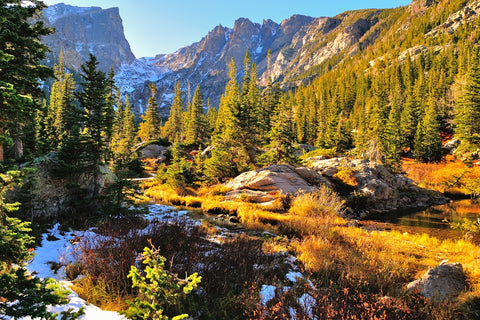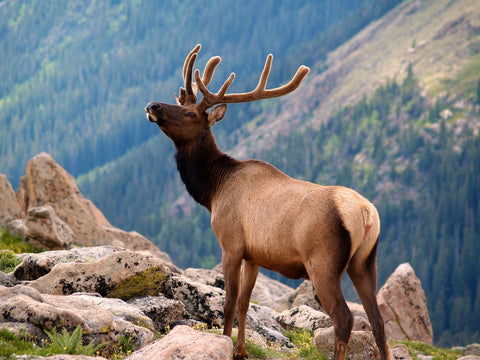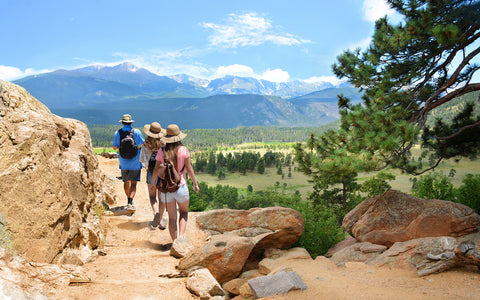Where is Rocky Mountain National Park
You’re on top of the world when you’re in Rocky Mountain National Park. It’s located in northern Colorado a few hours south of the Wyoming state line. Cheyenne, Wyoming is only an hour and 45 minutes away. The park is less than two hours from both Denver and Boulder, Colorado. Rocky Mountain National Park is sandwiched between the Arapaho and Roosevelt National Forests. The Rockies span the Continental Divide. The park is a pristine wilderness made up of rugged mountains, dense forests and alpine tundra.
How Big is Rocky Mountain National Park? The park is huge! As one of the biggest national parks, it stretches across 415 square miles. Those miles are filled with campgrounds, trails, mountains, forests, waterways, waterfalls, and wildlife. In fact, there are about 355 miles of hiking trails. Climbers from around the world come to scale the park’s pinnacles. The highest point in the park is Longs Peak, towering above the clouds at 14,259 feet. Big Thompson River is the lowest point in the park at an elevation of 7,630 feet.

Rocky Mountain National Park Weather
The Rockies have something special to offer guests each season. However, it is good to know what to expect before getting out there. The weather in the valleys tends to be warmer and milder. At higher elevations it’s not uncommon to see snow in July. In winter it snows at all elevations, but blizzards are common on the peaks. Spring can be warm and cold, with snow, rain or dry weather. Trail Ridge Road opens until mid-October. Summer brings brilliant blooms of wildflowers, wildlife is fully active, and thunderstorms are common. Fall is a popular time at the park. The weather is cool and dry. The aspen leaves change colors spectacularly. Elks begin to mate in September through October.

When did Rocky Mountain become a National Park
The mountains are millions of years old, only becoming hospitable in the last 11,000 years. America acquired the land with the Louisiana Purchase in 1803. The gold rush of 1859 drew in miners, trappers and settlers. The 1900s saw tourists and an emphasis in conservation. President Woodrow Wilson signed the Rocky Mountain National Park Act on January 26, 1915.
Things to do in Rocky Mountain National Park
There's so much to enjoy on a visit to Rocky Mountain National Park. Each season presents unique experiences. Our National Park Visitors Guide outlined ten of the most popular attractions in the list below.
Longs Peak
Longs Peak towers above the rest of the mountain tops. It stands at an elevation of 14,259. The peak can be seen from almost anywhere in the park. It offers hiking, climbing, skiing and wildlife photography opportunities. The Colorado state quarter features Long Peak.
Dream Lake
Dream Lake is peaceful and picturesque, with Hallett Peak and Tyndall Glacier in the distance. In the early morning, Hallett Peak is reflected in the water. To reach the lake, take the Bear Lake Trailhead. Dream Lake rests at an elevation of 9,910 feet.
Trail Ridge Road
This scenic roadway is a must for every park visitor. Trail Ridge Road stretches 48 miles between Estes Park and Grand Lake. Enjoy inspiring views of the Rockies from every direction and wildflower displays. Observe wildlife and the stark change from alpine forest to tundra.
Beaver Meadows
Beaver Meadows features the Park Headquarters, picnic areas and trailheads. Stop at the Visitors Center for a map, survey the interpretive activities, or check out the gift shop. The meadow has excellent views of Longs Peak, Eagle Cliff Mountain, the valley and surrounding pine forests.
Moraine Park Museum
Near the base of Eagle Cliff Mountain, you’ll find the Moraine Park Museum and Amphitheater. The museum depicts the area’s history going back 100 million years. The museum features special traveling exhibits and a gift shop. Weddings and school programs are held at the amphitheater.
Emerald Lake
Emerald Lake is the jewel of the Rockies. It gets its name from its natural, rich, green color. The trail to Emerald Lake begins at Bear Lake Trailhead. You’ll pass Dream Lake along the way. Emerald Lake sits at an elevation of 10,110 feet.

Animals in the Rockies
Many creatures call the Rockies home including birds, mammals, reptiles, insects, fish and amphibians. There are over 140 species of butterflies alone! The park is a safe haven for black bears, bighorn sheep, moose, pika, salamanders, ptarmigan, owls, passerines and even the threatened Canada lynx.
Alberta Falls
One of the most popular trails and attractions in the park is Alberta Falls. The waterfall is only a short hike from the Glacier Gorge Trailhead. Alberta Falls is 30 feet tall. The waterfall is named after Alberta Sprague, one of the area's original settlers.
Forest Canyon Overlook
Touted as one of the best views in the park, Forest Canyon Overlook is a must see. It’s above the treeline, offering complete views of the tundra biome. It’s breathtaking at sunrise and sunset. The overlook is just an easy walk from its parking lot.

Hiking Trails
The wilderness of the Rockies is gorgeous and immense. There are hundreds of miles of trails at the park for you to explore. The park features three types of trails with different difficulty levels: Lake Hikes (fairly easy), Waterfall Hikes (moderate), and Summit Hikes (challenging).
When to go to Rocky Mountain National Park
Rocky Mountain National Park is open year-round, 24 hours a day. The best time to visit the Rockies completely depends on your preferences and what you want to do while you’re there. The park is the most accessible June through September. It’s the perfect time for hiking, camping, swimming, fishing and more! It’s also when the park is the busiest. October through May is an excellent time for cross-country skiing and solitude. Elk are easily spotted throughout the park. For bird watching, blooming wildflowers and flowing waterfalls, come in the spring. Fall is crisp and cool with clear skies, the perfect time to hit the hiking trails. Plus, the aspen leaves start to transition into brilliant displays of autumn colors.
Must-Have things to bring to the Rocky Mountains
When you’re adventuring in the Rocky Mountains, you need to come prepared. There are some supplies that you should always bring with you on wilderness outings; List of Parks has listed some below:
Hiking Boots
Save your feet and ankles from sprains, cuts and breaks by wearing proper footgear. You need to wear sturdy hiking boots that are broken in. Boots that are breathable, waterproof, and lightweight are a good idea for traversing tricky trails, surging springs and snowy peaks.
Rain Jacket and Cold Weather Layers
Rain, sleet and snow are very common, especially as you ascend. Stay dry and warm to prevent hypothermia while you are exposed to the elements. You’ll want a waterproof rain jacket to keep you dry as well as several clothing layers suitable for cold weather.

Rock Mountains Park Maps
The rolling Rocky Mountains are vast and rugged. It is very easy to get lost or turned around. The best thing you can do is bring a park map with you. It’s also a good idea to download a map to your phone or GPS.
Water
If you’re going out on the trails, you need to bring water with you. A couple of bottles at minimum. It is a good idea to also bring a hydration filtration system so you can refill your bottles from streams even deep in the backcountry.
Food
There are only a few options for food and groceries at Rocky Mountain National Park. It is highly recommended that you bring your own supply of food. Trail snacks fit great into day packs. Bring a cooler so you can stock up on camp meals.
Sunglasses, Sunscreen and a Hat
The sun gets stronger the higher you climb in elevation. You need to bring a hat and sunglasses to protect yourself from sunburn, dehydration and overheating. Sunscreen should be applied liberally and frequently. Opt for a sunscreen that is waterproof and SPF 50 or greater.
Binoculars
For the best views, bring along some binoculars. You can catch a glimpse of mountain climbers clinging to the cliff sides. For bird watchers they’re a must. Binoculars also make it easier to spot animals like bears, bighorn sheep and elk from a safe distance.

Headlamp
Getting around camp at night might be tricky without a headlamp. The park is incredibly dark when the sun goes down. The only light is from the starry night sky. Headlamps make navigating the dark much easier, but they also help you spot nocturnal wildlife.
Bug Spray
Mosquitos and ticks thrive in Rocky Mountain National park, especially in spring and summer. Make sure you bring bug spray or repellent so they don’t bug you while you’re enjoying the park. Having an insect repellent handy for your pets is a good idea too.
Day Pack
You’re going to want a nifty travel pack to bring all your necessities when you leave camp and hit the trails. Invest in a lightweight bag with sturdy zippers and plenty of pockets. Having some kind of reflective material sewn on is also a plus.
Where to stay in Rocky Mountain National Park
Unlike most other US National Parks, there are no lodges to accommodate guests at Rocky Mountain National Park. The park does feature an abundance of campgrounds, campsites and backcountry rest areas for backpackers. Some are first come first serve while others require a reservation. There are plenty of chalets, campgrounds, cabins, rentals, and hotels in the mountain towns around the park. This park is a very popular destination so booking your spot early is highly recommended.

Food Near the Rocky Mountains
There are some delicious eateries in the mountain towns around the park. Inside the park there are few options for food. There is one restaurant inside the park which features a cafe and a coffee bar. A few sites have limited concessions. There are no grocery stores in the park. It is best to pack some sustenance for your trip.
Airports near Rocky Mountain National Park
There are plenty of ways to fly in for your visit to Rocky Mountain National Park. The Denver International Airport is the closest hub at just over 2 hours away. It’s the state’s biggest airport. Colorado Springs Airport and Eagle County Regional Airport are fairly close as well. The Aspen Pitkin County Airport offers some of the most affordable fares.

